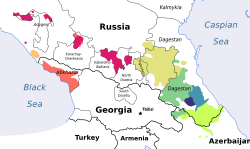This article has multiple issues. Please help improve it or discuss these issues on the talk page . (Learn how and when to remove these messages)
|
| Aghul | |
|---|---|
| агъул чӀалağul ç̇al | |
| Native to | North Caucasus, also spoken in Azerbaijan |
| Region | Southeastern Dagestan |
| Ethnicity | Aghuls |
Native speakers | 33,182 (2020 census) [1] |
| Cyrillic | |
| Official status | |
Official language in | Russia
|
| Regulated by | Gamzata Tsadasa Institute of Language, Literature and Art |
| Language codes | |
| ISO 639-3 | agx |
| Glottolog | aghu1260 Aghulic aghu1253 |
| ELP | Aghul |
 Aghul | |
 Agul is classified as Definitely Endangered by the UNESCO Atlas of the World's Languages in Danger (2010). | |
Aghul is a Lezgic language spoken by the Aghuls in Azerbaijan and Southern Dagestan in Russia. It is spoken by about 33,200 [1] people (2020 census).

